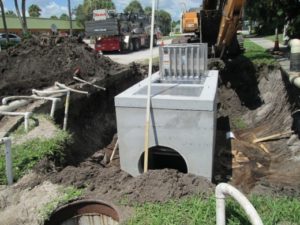An ongoing study in the City of Tampa seeks to improve the effectiveness of a commonly used tool for trapping stormwater debris before it reaches Tampa Bay and the Hillsborough River. 
The study, a joint effort of the city’s stormwater managers and University of South Florida researchers, is documenting yard waste, trash and sediment from every “baffle box” installed in Tampa. The boxes are underground concrete containers that slow stormwater down so sediments sink to the bottom where they can be vacuumed out. Baffle boxes also are intended to intercept trash, leaf litter and lawn clippings.
Baffle boxes are one part of our stormwater system which is out of sight, out of mind for many of us. But the underground structures play an important role in capturing debris before stormwater reaches our waterways. Baffle boxes are often used in urban settings because they require no additional land. Over the last 15 years, the city of Tampa has installed 47 baffle boxes in areas where construction of stormwater ponds is not possible or would be too costly.
City workers have been monitoring the boxes for years, but only in terms of how many inches of sediment they could document with a dipstick, said Heather Maggio, an environmental scientist with the city’s stormwater department. As part of the new study, a contractor will weigh everything that is removed from each baffle box. Over time, the city and USF hope to quantify the sediment, debris, lawn litter and nitrogen each box collects to determine exactly how effective they are.

The information can be used to tweak design and maintenance of baffle boxes for improved performance.
Researchers divided the city into three regions – south Tampa, downtown and the northern sector near USF – and visited each baffle box. They documented the type of box – technology has improved significantly over the years – and land uses in the surrounding areas. They also took water quality samples and made specific recommendations for retrofitting each box.
In South Tampa, for instance, 11 of the 17 baffle boxes installed are in such low locations they continually flooded during high tides because they are below mean high water levels, said Mauricio Arias, a USF engineering professor. That may impact their ability to filter sediments and encourage the growth of oysters or barnacles that could potentially block water flow.
As part of the city’s ongoing maintenance plan, gates will be installed both above and below the baffle boxes in low-lying areas so that the boxes have a chance to dry out and a vacuum truck can collect sediment without excessive water flowing in, Maggio said.
Tidal flow also may become an issue with the newer baffle boxes third-generation hydrodynamic boxes installed at Curtis Hixon Waterfront Park because of sea level rise. Other boxes in downtown Tampa generally are less likely to flood but may not be as effective as they could be because the inlets into them are small, said Arias.
Land uses near the baffle boxes also impact what they collect, notes Taryn Sabia, a researcher with USF’s School of Architecture and Community Design. “In some areas, screens in baffle boxes collect more trash,” she said. “In other places, yard waste is a bigger issue.”
Leaves from tree canopies in north Tampa are affecting the performance of baffle boxes there, and maintenance should be rescheduled to focus on removing leaves in spring as well as sediment after the rainy season, Arias said. The city plans to retrofit the older baffle boxes with screens that capture trash and yard waste.
The second phase of the study includes installation of automated samplers at four locations to determine how much nitrogen is removed from the water with the sediments, Maggio said.
[su_divider]
